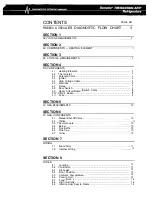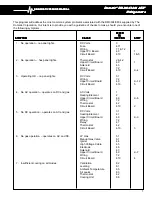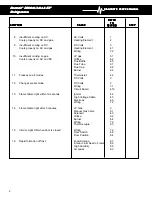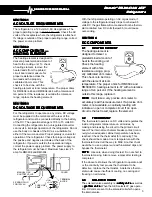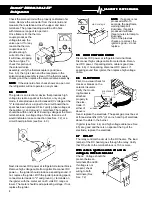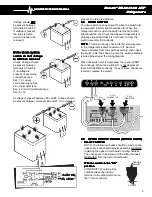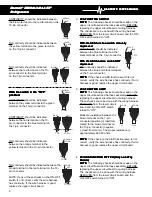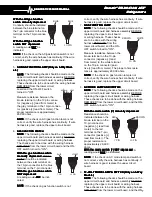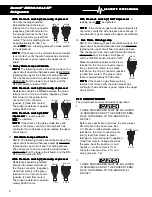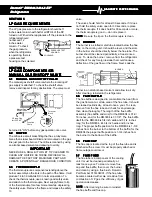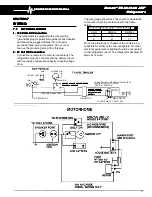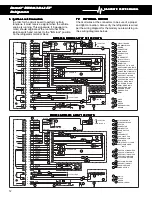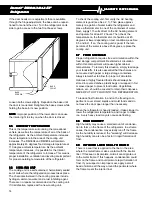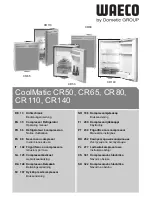
14
DIAGNOSTIC SERVICE MANUAL
DIAGNOSTIC SERVICE MANUAL
DIAGNOSTIC SERVICE MANUAL
DIAGNOSTIC SERVICE MANUAL
DIAGNOSTIC SERVICE MANUAL
Dometic
Dometic
Dometic
Dometic
Dometic
®
®
®
®
®
RM3604/3804 AES
RM3604/3804 AES
RM3604/3804 AES
RM3604/3804 AES
RM3604/3804 AES
®
®
®
®
®
Refrigerators
Refrigerators
Refrigerators
Refrigerators
Refrigerators
If the door needs more adjustment than is available
through the hinge adjustment, the base can be reposi-
tioned to reorient the door. Turn the refrigerator on its
side to gain access to the two front base screws.
Loosen both screws slightly. Reposition the base until
the door is reoriented. Retighten the base screws while
holding the base in its new position.
NOTE
NOTE
NOTE
NOTE
NOTE: Improper position of the lower door can cause
the interior light to stay on when the door is closed.
8.5
8.5
8.5
8.5
8.5
AMBIENT TEMPERATURE
AMBIENT TEMPERATURE
AMBIENT TEMPERATURE
AMBIENT TEMPERATURE
AMBIENT TEMPERATURE
This is the temperature surrounding the recreational
vehicle, as well as the temperature of air at the back of
the refrigerator. As the ambient temperature increases,
the air temperature in the area of the cooling unit
increases. The RM3604 and RM3804 will maintain
approximately 43 degrees food storage temperature at
110 degree ambient temperature. As the ambient
temperature increases, it is possible for the interior
temperature of the refrigerator to increase. This means
proper installation, ventilation and leveling are important
for proper operating temperature of the refrigerator.
BASE
SCREWS
BASE
FRONT
8.6
8.6
8.6
8.6
8.6
COOLING UNIT
COOLING UNIT
COOLING UNIT
COOLING UNIT
COOLING UNIT
The cooling unit is a self-contained, hermetically sealed
set of coils where the refrigeration process takes place.
The chemicals involved in the cooling process include
hydrogen, ammonia, water and a rust inhibiting agent.
There are no repairs recommended on the cooling unit.
If it is defective, replace with a new cooling unit.
To check the cooling unit, first verify the AC heating
element is good (see Sec. 2.1). Then place approxi-
mately one gallon of water inside the refrigerator and
place a thermometer in one of the containers of water.
Next, supply 115 volts direct to the AC heating element
and operate for at least 12 hours. Then check the
temperature on the thermometer. It should be at 45
degrees or lower depending on test conditions (see Sec.
8.5 and 8.2). If so, the cooling unit is good. If the tem-
perature of the water is above 45 degrees, replace the
cooling unit.
8.7
8.7
8.7
8.7
8.7
FOOD STORAGE
FOOD STORAGE
FOOD STORAGE
FOOD STORAGE
FOOD STORAGE
Proper refrigeration requires free air circulation within the
food storage compartment. Restricted air circulation
within this compartment will cause higher cabinet
temperatures. To remedy this situation, simply rearrange
your foodstuffs. It is also essential that the shelves are
not covered with paper or large storage containers.
Always remember to allow for proper air circulation.
Odorous or highly flavored foods should always be
stored in covered dishes, plastic bags or wrapped in foil
or waxed paper to prevent food odors. Vegetables,
lettuce, etc., should be covered to retain their crispness.
NEVER PUT HOT FOOD INTO THE REFRIGERATOR.
To reduce frost formation in and on the freezing com-
partment, cover stored liquids and moist foods and do
not leave the door open longer than necessary.
When the refrigerator is heavily loaded, it takes longer to
lower the refrigerator temperature, and longer to make
ice. A very heavy load may also cause defrosting.
8.8
8.8
8.8
8.8
8.8
HIGH HUMIDITY
HIGH HUMIDITY
HIGH HUMIDITY
HIGH HUMIDITY
HIGH HUMIDITY
High humidity may cause a small amount of condensa-
tion to form on the frame of the refrigerator. In extreme
cases, the condensation may actually run off the frame.
As the humidity is reduced, the "sweating" will decrease.
High humidity can also be a factor in rapid formation of
frost.
8.9
8.9
8.9
8.9
8.9
INTERIOR LINER SEAL TO FRAME
INTERIOR LINER SEAL TO FRAME
INTERIOR LINER SEAL TO FRAME
INTERIOR LINER SEAL TO FRAME
INTERIOR LINER SEAL TO FRAME
There is a seal that is applied to the liner in the area
where the metal frame makes contact with the interior
liner. If this seal is incomplete, cold air can migrate out
to the metal frame. If this happens, condensation could
form on the frame and could promote rapid formation of
frost. If you suspect an improper seal, apply a small
bead of silicone all the way around the perimeter where
the frame meets the interior liner.

